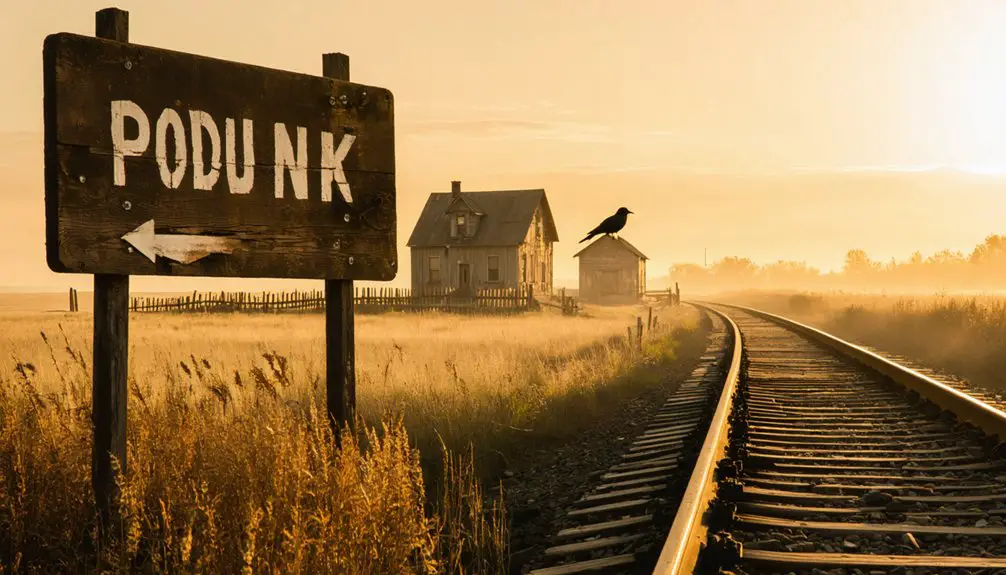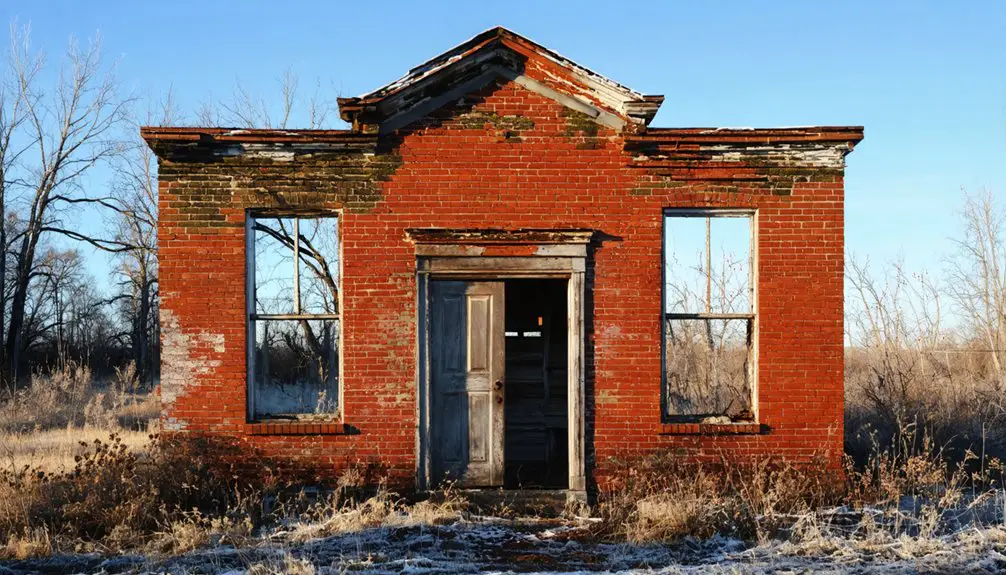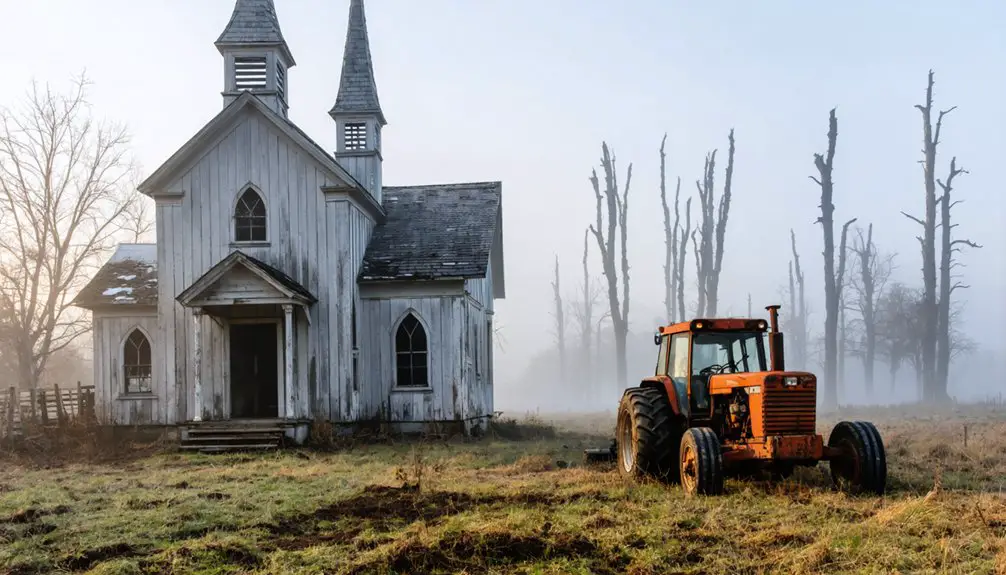You’ll find Podunk, Michigan at the intersection of Ziemer and N. Shearer roads in Gladwin County, where a lumber settlement flourished in the 1860s. The community, named after settler George Judson, centered around a schoolhouse and Free Methodist church until water shortages and missed railroad opportunities sealed its fate. Today, only the relocated schoolhouse and an artistic Tractor-henge installation mark this hidden piece of Michigan’s heritage, where untold stories still echo through unmarked dirt roads.
Key Takeaways
- Podunk was established in the 1860s as a farming and logging settlement in Gladwin County, Michigan, named after early settler George Judson.
- The town’s decline began when it was bypassed by the railroad and suffered from water supply issues in 1875.
- The historic Podunk Schoolhouse, relocated to Webster Village in 1992, remains the last physical reminder of the ghost town.
- Located at Ziemer and N. Shearer roads intersection, Podunk can be reached via M-18 highway but doesn’t appear on standard maps.
- The settlement’s economy collapsed after timber depletion, causing residents to migrate and leaving behind only remnants of its former existence.
The Rise and Fall of Rural Michigan’s Lost Settlement
While many small towns dotted Michigan’s rural landscape in the mid-1800s, Podunk’s story began distinctly in the 1860s as a humble farming and logging settlement in Gladwin County. Named after one of its earliest settlers, this rural community’s Podunk history centered around a schoolhouse built in 1904 and a Free Methodist church that served as gathering spots for locals.
The original settlement was established by George Judson in 1836, and the name Podunk came from the gristmill wheel sounds that local Chippewa Indians heard. You’ll find that Podunk’s community legacy was shaped by missed opportunities and natural challenges. When the railroad bypassed the settlement for nearby Fenton, and the local water supply was cut off in 1875, the town’s fate was sealed. Today, only an old schoolhouse remains at the intersection of Ziemer and N. Shearer roads.
Despite attempts to boost economic prospects, Podunk remained isolated, with its nearest store three miles away. The schoolhouse’s closure in 1955 marked the end of an era, leaving only scattered remnants of this once-hopeful settlement.
Finding Podunk: A Journey Down Dirt Roads
If you’re seeking the ghost town of Podunk, you’ll need to navigate the intersection of two unmarked dirt roads – Ziemer and N. Shearer – just off M-18 highway in Gladwin County.
Your journey through Michigan’s dense forests will require careful attention to GPS coordinates, as the site doesn’t appear on standard maps and lacks modern signage. Like several other Podunks across Michigan, this particular ghost town holds its own mysteries.
The old schoolhouse at the crossroads serves as your primary landmark, standing as one of the few remaining structures marking this once-thriving lumber settlement. Named after a Connecticut Indian tribe in the 1840s, Podunk’s historical significance endures despite never having its own post office.
Finding Podunk requires maneuvering through Michigan’s extensive network of rural roads, where 93,142 miles of routes wind through the state’s remote regions.
You’ll need to master rural navigation skills as you encounter unpaved surfaces, seasonal challenges, and limited cell reception. Dirt road safety becomes essential when facing variable conditions like mud, washboarding, and loose gravel. County road crews maintain these routes and remain on-call 24/7 to address deteriorating conditions.
For successful exploration, you’ll want to equip yourself with paper maps and offline GPS devices, as digital navigation often proves unreliable in these areas. Rural roads benefit from smarter spending strategies rather than just increased funding to maintain their conditions.
Watch for abrupt curves, blind spots, and wildlife crossings while maintaining slower speeds on these less-traveled paths. Remember that these backroads experience crash rates 2.6 times higher than urban streets, so pack emergency supplies and plan your route carefully through Michigan’s rural maze.
Hidden Among the Trees
Tucked away at the crossroads of Ziemer and N. Shearer roads, Podunk’s hidden history lies shrouded by dense Michigan forest.
Like many sparsely populated settlements established in the 1800s, this area gradually faded into obscurity.
You’ll find the ghost town’s remnants challenging to spot through the thick canopy of trees that have reclaimed much of the original settlement. The 1904 schoolhouse stands as your primary landmark, a silent sentinel marking forgotten pathways through the wilderness.
As you navigate this remote location, you won’t find it on Google Maps, and the dirt roads leading here demand careful attention.
Beyond the schoolhouse and a few scattered houses, nature has embraced most traces of civilization. The local “Tractor-henge” installation serves as an unconventional waypoint, while the surrounding woods hold secrets of foundations and artifacts, waiting for those determined enough to seek them out.
Following Historical Travel Routes
The journey to Podunk begins where modern guidance ends, at the turn-off from M-18 onto the dusty paths of Gladwin County.
You’ll find yourself navigating the intersection of Ziemer and N. Shearer Roads, historic routes that once carried lumber and settlers through Michigan’s northern wilderness. These unpaved paths hold deep historical significance, leading you past the iconic 1904 schoolhouse that stands as a symbol to Podunk’s bygone era. Situated north of Gladwin, this rural landscape reveals the region’s agricultural roots.
As you traverse these rural backroads, you’re retracing the steps of early 20th-century travelers.
The surrounding forests and unusual roadside attractions like “Tractor-henge” make this rural exploration uniquely compelling. Just half a mile further, you’ll discover Hard Luck ghost town, creating an opportunity to explore multiple abandoned settlements along these time-worn dirt trails.
Tales From the Crossroads of Ziemer and N. Shearer
Standing at the quiet intersection of Ziemer and North Shearer roads in Gladwin County, you’ll find what remains of Podunk – a weathered schoolhouse and scattered homes that hint at a once-bustling lumber community.
In the 1860s, this crossroads played host to Michigan’s logging heritage, where hardworking families carved out lives amid the timber boom. The nearby Bland Cemetery tells their stories through weathered gravestones bearing names like Bland, Ames, and Huff – pioneers who shaped this forgotten corner of Michigan’s north woods. The cemetery contains eighteen marked graves, most dating back to the late 1800s. A Methodist church was added to the landscape around 1935, further cementing the town’s identity.
Today, you won’t find Podunk on modern maps, but the mysteries of its past linger. Family histories intertwine at these crossroads, from Paul Verno’s complex tale to countless untold stories of survival, loss, and perseverance in this once-thriving logging settlement.
The Mystery Behind Podunk’s Naming

How a small Michigan logging settlement came to be known as “Podunk” remains one of Gladwin County’s enduring mysteries.
You’ll find competing theories woven into local Podunk folklore, including claims that the town was named after an early settler bearing that surname. Yet the cultural significance of “Podunk” as a term for remote, insignificant places might’ve influenced the naming.
What’s particularly intriguing is that you can trace this settlement’s modest beginnings to the 1860s, when it emerged as a farming and logging community.
While the town never grew large enough for a post office, it did establish core landmarks like its 1904 schoolhouse and Free Methodist church.
Without definitive historical documentation, the true origin of Podunk’s name remains tantalizingly unclear, preserved in the stories of its remaining residents.
Life in a Forgotten Farming Community
Despite its humble origins, Podunk’s farming community took root in the 1830s when George Judson purchased vast acreage in Mundy Township, establishing essential infrastructure that would shape rural life for generations.
You’d have found a tight-knit community facing constant farming struggles, from depleted soil to wildfire damage. The Free Methodist church, dance hall, and Podunk School served as crucial gathering places where up to 83 students paid their tuition in firewood.
Neighbors pulled together to build barns and share seasonal labor, showing remarkable community resilience in the face of isolation and economic hardship.
Through shared labor and steadfast cooperation, rural communities found strength to overcome the harsh realities of frontier farming life.
While many farms ultimately failed due to poor soil conditions, the community’s spirit lived on through shared facilities, multi-generational farmsteads, and cultural contributions like May Mast’s poetry and paintings.
The Old Schoolhouse: Last Standing Sentinel

A lonely belfry pierces the Michigan sky where Podunk School has endured since 1846, marking nearly two centuries of rural education at its original Walsh Road location before its 1992 relocation to Webster Village.
You’ll find this schoolhouse heritage preserved in every detail – from the wood-burning stove that kept students warm to the kerosene lamps that lit their studies until electricity arrived in 1935.
As one of seven district schools in Webster Township, it’s where up to 83 pupils once gathered, though enrollment dwindled to just 7-13 students by the 1930s.
Today, this educational legacy stands as Podunk’s last physical reminder, outlasting the ghost town’s other structures. While students once hauled water from a nearby farmhouse until 1900, the schoolhouse now serves as a cherished landmark of Michigan’s rural past.
Water, Timber, and Survival
Like many northern Michigan lumber settlements, Podunk’s survival hinged on the twin pillars of water access and timber resources.
You’ll find traces of the town’s strategic location near waterways that enabled timber techniques such as river log drives, while wells and small-scale water systems sustained the community’s basic needs.
When the timber companies arrived, they transformed Podunk into a bustling logging camp.
But water scarcity and seasonal variations challenged both logging operations and farming efforts.
You’d have seen workers maneuvering log-filled rivers during spring thaws, while families tended subsistence gardens to supplement their logging income.
Once the valuable timber disappeared, so did Podunk’s economic lifeline.
Without reliable water routes or rail connections to sustain alternative industries, the town couldn’t escape the fate that befell countless other logging communities.
Vanishing Tracks: Railroad Legends
If you visit Podunk today searching for evidence of the Pere Marquette Railroad that once served this ghost town, you’ll find no physical traces of tracks or the train station that connected it to Michigan’s broader rail network.
Local legends tell conflicting stories about whether rail service reached directly into Podunk or if residents had to travel to a nearby depot, though historical records confirm the Pere Marquette did operate in the region.
The mystery of Podunk’s vanished railroad infrastructure mirrors many Michigan ghost towns where tracks were removed and stations dismantled as rail service declined in the mid-20th century.
Railroad Myths vs. Reality
While many visitors to Podunk imagine perfectly preserved railroad tracks stretching through Michigan’s ghost town landscape, the reality differs sharply from local legends.
You won’t find intact rails running through the remnants of this once-bustling community – most were removed or reclaimed decades ago. Railroad history enthusiasts might spot old roadbeds or occasional railroad ties, but the extensive infrastructure described in local tales has largely vanished.
The truth behind Podunk’s decline involves more complex economic shifts than just the loss of rail service. While trains certainly brought prosperity during the town’s heyday, factors like resource depletion and broader market changes ultimately sealed its fate.
Today, you’ll mainly find traces of homes, stores, and civic buildings rather than the mythologized rail infrastructure that features so prominently in local lore.
Searching for Lost Tracks
Though railroad enthusiasts search diligently for traces of Podunk’s rail history, finding physical evidence proves increasingly challenging.
Nature has reclaimed the tracks that once connected this forgotten community to the Pere Marquette Railroad network, leaving no visible rails where trains once rumbled past the cemetery and church.
You’ll need to rely on historical maps and railroad directories like Graydon M. Meints’ “Along The Tracks” to trace these lost railways.
The Gladwin Branch of the Michigan Central Railroad, which served nearby Hardluck, offers clues about track positioning.
When you explore the area today, you’re searching through transformed landscapes – dense forests and farmland have replaced what was once an essential transportation artery linking Podunk’s lumber and farming operations to larger markets.
Missing Train Station Mystery
One enduring mystery surrounds Podunk’s vanished train station and rail infrastructure.
You’ll find no visible traces of the tracks or station that once served this small Michigan community, despite historical records confirming railroad service existed. Local theories suggest various explanations for the disappearance, from intentional track removal to economic decline forcing abandonment.
- No official records detail a formal station structure
- Track removal likely coincided with lumber industry’s decline
- Railway infrastructure may have been salvaged for resources
- The station might’ve been just a simple loading point
While the exact fate of Podunk’s train station remains unclear, its disappearance mirrors the broader story of Michigan’s vanishing rural rail networks.
The missing infrastructure stands as a reflection of the economic shifts that transformed countless small communities into ghost towns.
From Bustling Settlement to Ghost Town
During Michigan’s lumber boom, Podunk emerged as a thriving settlement in Gladwin County, bustling with lumberjacks and mill workers who followed the region’s abundant timber opportunities.
The town’s lumber legacy included railway access for timber transport and essential community structures, with the old schoolhouse still visible today.
Like many northern Michigan settlements, Podunk’s fate was sealed when the surrounding forests were depleted.
Once the timber disappeared, so did the economic foundation of the community. Workers moved on to follow available jobs, while some residents relocated their homes to growing towns nearby.
What remains of this ghost town serves as a stark reminder of how quickly resource-dependent communities can rise and fall when their primary industry vanishes.
Modern-Day Traces and Tractor-henge
Deep within Gladwin County’s winding dirt roads, at the quiet intersection of Ziemer and N. Shearer, you’ll find the ghostly remains of Podunk.
Your Podunk exploration reveals a solitary 1904 schoolhouse standing as a monument to this forgotten settlement. Nearby, at Eagleson and N. Bard roads, you’ll discover Tractor-henge art – a striking installation of John Deere tractors arranged in creative poses across farmland, echoing Texas’s famous Cadillac Ranch.
- The old schoolhouse operated until 1955, marking over 50 years of local education.
- No railroad tracks remain despite historical evidence of service.
- You won’t find Podunk on most online maps – physical exploration is essential.
- Tractor-henge sits on private land, offering a unique blend of agricultural heritage and artistic expression.
Both sites capture Michigan’s rural spirit, though accessing them requires careful navigation of seasonal dirt roads.
Frequently Asked Questions
Are There Any Documented Paranormal Activities or Ghost Stories About Podunk?
You won’t find documented ghost sightings or haunted locations here – research shows no specific paranormal activities recorded in the area’s history, though the old schoolhouse draws historical interest.
What Happened to the Families Who Originally Lived in Podunk?
Ever wonder what becomes of those who leave a dying town? You’ll find these families relocated to nearby Michigan communities like Gladwin and Harrison, though some scattered west, leaving only ghostly legends behind.
When Was the Last Permanent Resident Recorded Living in Podunk?
You won’t find a documented final resident of this settlement, though population decline patterns suggest the last residents likely departed by the late 1930s, following regional ghost town trends.
Did Any Notable Historical Figures Ever Visit or Live in Podunk?
Despite being home to over 100 early settlers at its peak, you won’t find any famous visitors or historic events involving notable figures in Podunk’s history. No documented evidence exists of celebrity residents.
What Indigenous Tribes Inhabited the Podunk Area Before European Settlement?
You’ll find that the Ojibwe, Odawa, and Potawatomi tribes maintained rich tribal cultures in this region, establishing seasonal settlements and managing local resources with deep historical significance to Michigan’s early landscape.
References
- https://99wfmk.com/podunkmichigan/
- https://www.mycitymag.com/podunk-house-pioneer-museum-preserve-yesterday-honor-today-plan-tomorrow/
- https://www.nailhed.com/2019/07/hard-luck-and-tractor-henge.html
- https://lostinmichigan.net/the-ghost-town-of-podunk/
- https://lostinmichigan.net/old-barn-near-podunk/
- https://www.instagram.com/p/C54Yv69MsCg/
- https://en.wikipedia.org/wiki/Podunk
- https://mdotjboss.state.mi.us/SpecProv/getDocumentById.htm?docGuid=9e28b8ad-8b90-4498-8db0-de022c492028
- https://www.michigan.gov/-/media/Project/Websites/MDOT/Programs/Planning/MDOT-Fast-Facts.pdf?rev=de1d1e8e15cd4217b342bd80cd33e910
- https://rosap.ntl.bts.gov/view/dot/36748



